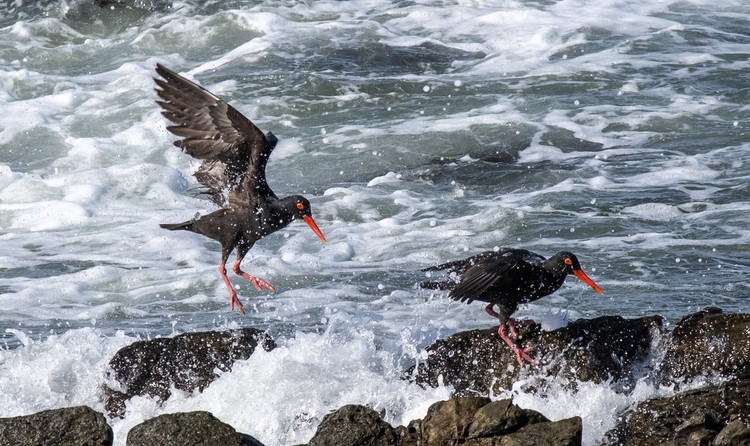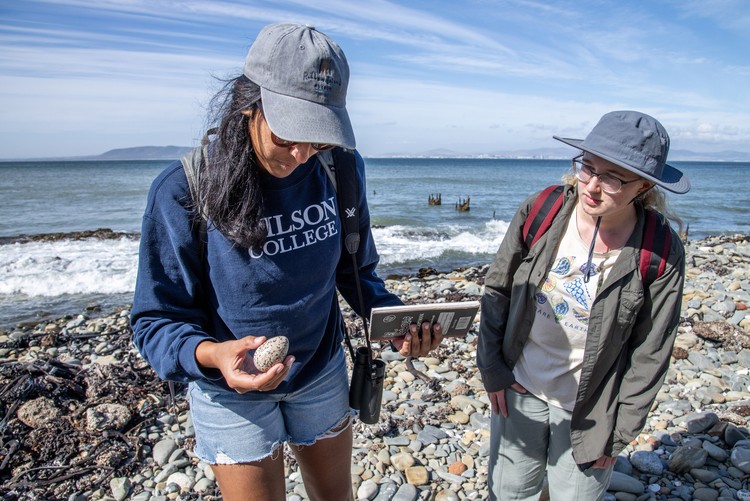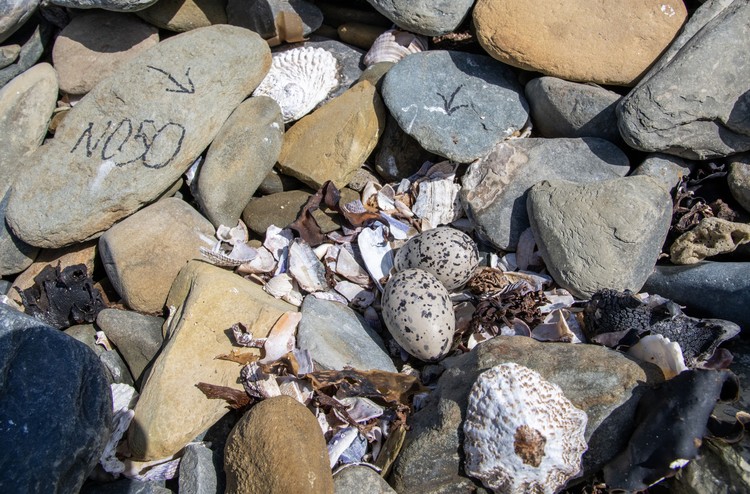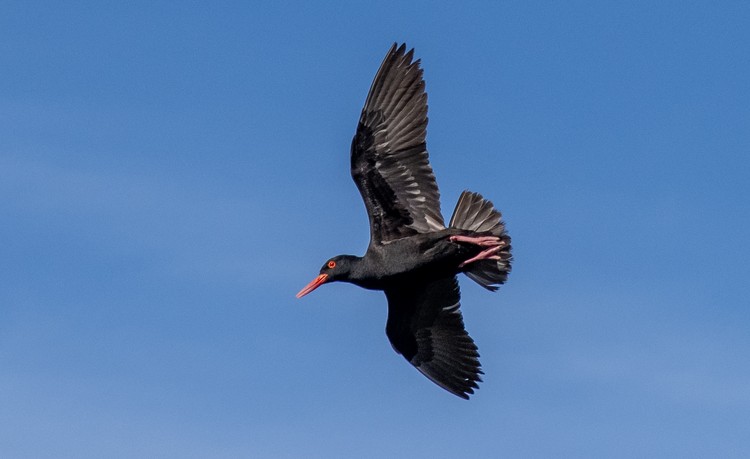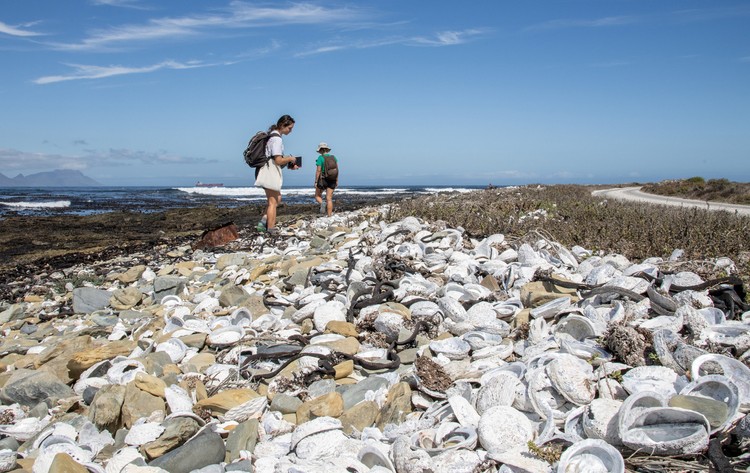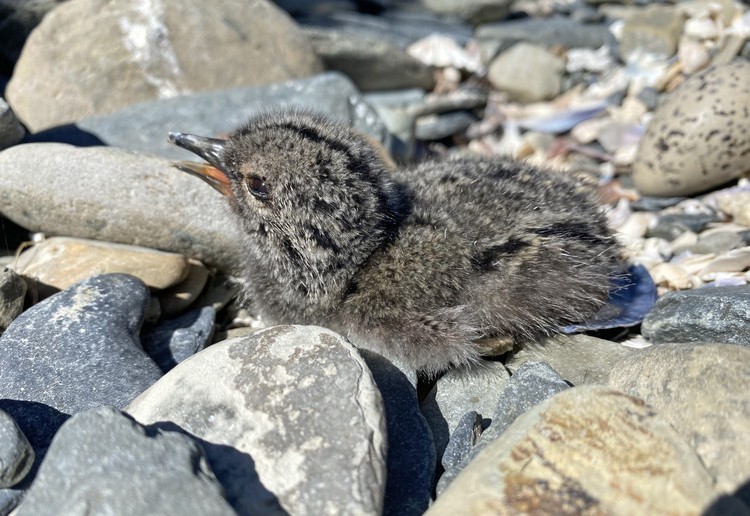African Oystercatcher bucks the trend in crashing bird populations
The species has gone from “Near Threatened” to “Least Concern” on the Red Data List
A pair of adult African Oystercatchers in the surf zone at Robben Island, where the species is thriving. Photos: John Yeld
- The iconic African Oystercatcher has made a dramatic recovery from its “Near Threatened” status on the Red Data List.
- The Robben Island population of the species has increased four-fold over the past two decades.
- But the species is highly vulnerable – a single storm surge can effectively wipe out a season’s breeding effort.
Conservation success stories are often eclipsed by harrowing accounts of biological disaster and environmental tragedy – but one southern African bird species is providing a happy exception, to the delight of biological scientists and the conservation community.
This is the striking African Oystercatcher, an iconic coastal bird whose glossy black plumage, bright orange-red eye-ring and dagger-like bill make it instantly recognisable in the narrow inter-tidal zones of South Africa and Namibia where it lives.
Bucking a staggering downward trend in bird numbers globally, the handsome oystercatcher has recorded a substantial population growth over the past decades – so much so that its IUCN (World Conservation Union) Red Data List status has been downgraded from Near Threatened to Least Concern.
This increase is confirmed at a key breeding site on Robben Island, where the remarkable success story of Haematopus moquini (named by Napoleon Bonaparte’s nephew Charles in 1856) is being closely documented by researchers, assisted by passionate volunteer citizen scientists in a study running since 2001.
The project – started as a joint initiative of UCT and the Robben Island Museum heritage unit – now falls under the Rondebosch-based Biodiversity and Development Institute (BDI). The BDI is an independent, non-profit company staffed by academics and designed to foster research and community action in the fields of biodiversity conservation and social development.
BDI founder and director Professor Les Underhill, a retired professor of statistics at UCT, is a life-long, highly decorated birder with a particular interest in coastal and wading birds, bird ringing, and promoting citizen science in biology while solving environmental problems.
Karis Daniel (left), coordinator of the Biodiversity & Development Institute’s African Oystercatcher research project on Robben Island, and volunteer Robyn Smith examine an egg from a nest on the northern side of the island.
In the early 1980s, the overall African Oystercatcher population had plummeted to only about 4,800 adult birds, mostly because of human interference in its very narrow coastal breeding habitat. The situation remained dire into the 1990s.
Researchers found that in the 1996/7 season, for example, breeding success in this species’ key West Coast range was only about 15% of what was needed to maintain a stable population. On 60km of its Eastern Cape coastal habitat – an approximately 40-metre wide strip around the high-water mark – they found no evidence of successful breeding whatsoever.
But a multidisciplinary, national oystercatcher conservation programme was initiated in 1998, and it soon achieved success.
One of the main reasons for the species’ sharp population recovery was the 1979 local appearance and then rapid spread of the alien Mediterranean black mussel. Since the invasion, these mussels constitute more than 90% of the oystercatchers’ diet.
A second key factor was the national ban on beach driving, introduced in December 2001.
A third factor was more effective conservation management on the breeding islands.
A typical African Oystercatcher nest, little more than a scrape among shells and seaweed. The non-permanent number helps researchers re-locate the nest during monitoring over several weeks.
Underhill was able to report that the oystercatcher population was estimated at 6,670 birds in the early 2000s – an increase of 46% since the early 1980s – and was continuing to rise. Also, its breeding range had extended northwards along the KZN coastline.
On predator-free islands, oystercatcher pairs now successfully raise on average one chick every two to three years – nowhere near as fecund as many other bird species, but nevertheless sufficient to maintain those island populations and to provide some “surplus” birds.
African Oystercatchers mate for life and do not migrate, being strongly territorial and relying on local shellfish supplies year-round. Some surplus birds not able to achieve a territory of their own leave the island and head for the mainland, but breeding success here is limited.
An African Oystercatcher in the air over Robben Island, where researchers have recorded a four-fold increase in numbers of this species in 20 years.
Robben Island, just less than 10km in circumference, holds some 8% of the global African Oystercatcher population, making it a very important breeding site.
In 2001, Underhill and his BDI colleagues initiated a long-term study of the species here, assisted by volunteers. Since then, the island’s oystercatcher population has increased four-fold and the number of nests has almost doubled.
The main reasons for this huge increase were the removal of feral cats, which were predating more than 80% of oystercatcher nests, as well as the removal of European rabbits and the sharply increased supply of alien black mussels.
The researchers’ record count came in the 2019/20 breeding season (November to March). During monitoring of oystercatcher breeding efforts every six days, they counted 550 birds and recorded 158 nesting attempts, thought to have been made by 133 nesting pairs. (Oystercatchers can lay a second time in a season if the first clutch is lost.) A further 300 or so non-breeding oystercatchers were also present.
Of the 158 clutches, 47% produced one or more hatchlings, and of a total of 288 eggs laid, 38% hatched.
In 2021/22, total of 176 nests were found on the island – a further 11% increase.
Although full statistics are still being gathered for this current 2023/24 breeding season that is now drawing to a close, some 450 adult birds and between 15 and 20 juveniles have been recorded during the two most recent weekly counts, as well as 130 to 140 nests.
“But a lot of those nests are actually re-nesting attempts after the eggs were washed away or predated, and then the adults tried again in the same spot,” explains current project co-ordinator postgraduate student Karis Daniel.
Amaia Sagarzazu (left) and Ángela Colina, interns from the Basque Country in Spain, monitoring African Oystercatchers’ breeding efforts on Robben Island for Biodiversity & Development Institute’s research project.
While oystercatcher chicks leave the nest within about 24 hours after hatching (they start to fly at about 40 days), they are still fed by their parents for about 100 days while their bills grow strong enough to prize shellfish off the rocks for themselves.
“So it’s quite good to have this many juveniles this early in the breeding season,” says Daniel.
Although this season’s numbers appear to be slightly down from the pre-Covid peak, this is not necessarily cause for concern, she adds.
“It could just be natural fluctuation as part of a long-term pattern. We have to look at it in the context of all the other years, and the population on Robben Island does seem to be doing well.”
Underhill confirms that African Oystercatchers have done well in recent decades, but he’s concerned about what he terms “their crazy vulnerability”.
“They breed about a metre from the spring high tide level, and nests have to survive two spring tides before they hatch. So a single storm surge event in the breeding season can wipe out all nests with eggs from Saldanha Bay all the way to Cape Agulhas,” he explains.
And if these events increase in frequency as a result of climate change, as is predicted, the oystercatchers “may once again be in trouble”, he warns.
A newly hatched African Oystercatcher chick on Robben Island. In the background (right) is its unhatched “twin”. Photo: Karis Daniel
Next: 450 families, one water tap in Cape Town informal settlement
Previous: Elections 2024: What the major political parties say about a sugar tax
© 2024 GroundUp. This article is licensed under a Creative Commons Attribution-NoDerivatives 4.0 International License.
You may republish this article, so long as you credit the authors and GroundUp, and do not change the text. Please include a link back to the original article.
We put an invisible pixel in the article so that we can count traffic to republishers. All analytics tools are solely on our servers. We do not give our logs to any third party. Logs are deleted after two weeks. We do not use any IP address identifying information except to count regional traffic. We are solely interested in counting hits, not tracking users. If you republish, please do not delete the invisible pixel.

